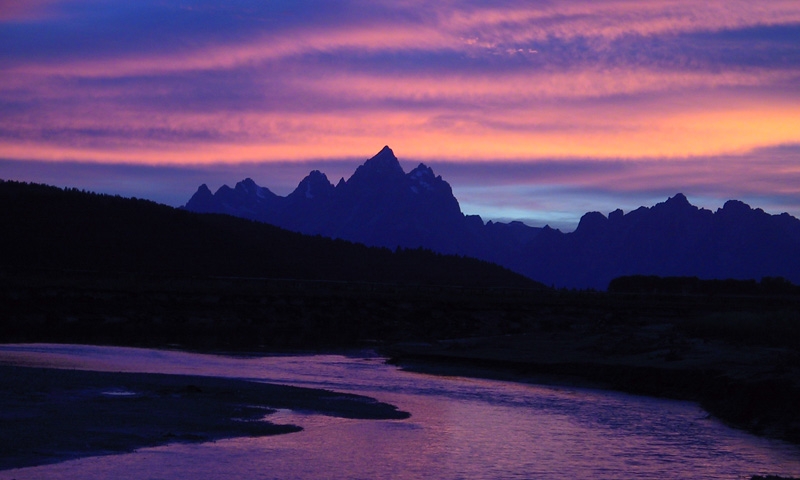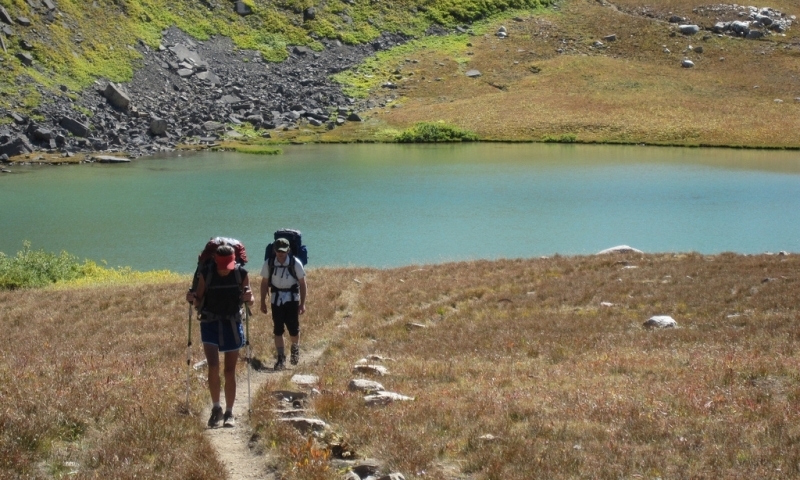Snowcapped, snaggle-toothed peaks in Grand Teton National Park are the quintessential mountain range in America. The diversity in this valley with its abundance of wildlife, along with the historic geologic processes set Grand Teton National Park in a class of its own.
Quick Facts:
- The Teton Range has more than twelve peaks at elevations greater than 12,000 feet.
- Its highest peak, the Grand Teton, reaches 13,770 feet.
- Seven moraine lakes run along the base of the range.
- More than 100 alpine lakes can be found in the backcountry.
- Over 200 miles of trails traverse through the mountainous terrain.
- 61 species of mammals and many species of birds call this park home.
Scenic Viewpoints along the Park Road
Scenic turnouts along your travels north are worth the stop, offering remarkable and dramatic views.
- Cathedral Group Viewpoint
The Cathedral Group is one of the most dramatic young fault scarps, cliffs formed by the movement of the fault, in the western United States. This area was formed by earthquakes only since glaciers receded about 14,000 years ago and illustrates how quakes in most recent prehistoric times helped build the Teton Range during the past 13 million years. - Mount Moran Viewpoint
Mount Moran is the northernmost of the high peaks in the Teton Range at 12,605 feet and has a flat eroded top. A vertical layer or "dike" is visible in Mount Moran, formed by molten rock squeezing upward into the granite rock. The peak is topped by a thin layer of sandstone, formed when the area was once a seafloor. This layer of sandstone is about 540 million years old, while the granites of Mount Moran are 2.4 billion years old. Also visible from the turnout is Falling Ice Glacier, one of the remaining active glaciers in the Tetons. - Snake River Overlook
The Snake River Overlook offers a view of Jackson Hole's most unusual feature, the valley floor's slight westward tilt. The slope is so gentle that it is difficult to observe by looking at the valley floor to the west. But the tilt is evident by looking west and noting that only the tops of tall pine trees are visible on the western edge of the valley. This is due to earthquake movements and to accumulation of sloping gravel and sediment deposits left by streams that once flowed from glaciers. - Oxbow Bend
Below the dam, traveling east toward the Moran entrance, the northern entrance of the park, lies a large oxbow-shaped bend in the Snake River. This spot, the Oxbow Bend Scenic Overlook, provides a classic view of Mount Moran. Skillet Glacier on Mount Moran is visible. - Signal Mountain
Jackson Point overlook on Signal Mountain is the most impressive highlight, with its panoramic views of the Teton Range, Jackson Lake, and Jackson Hole's glaciated landscape, the Snake River drainage, and the Pitchstone Plateau, which is the southernmost part of the Yellowstone Plateau.
Wildlife:
Viewing wildlife is one of the most popular and enjoyable activities within Grand Teton National Park. Often easily spotted from the road or park trails, you can spend hours watching wildlife. The following are common species to spot in the park: Trumpeter Swan, Elk, Moose, Bald Eagle, Antelope, Osprey, Bison, Black Bears, Marmots, and Pikas.
Hiking Trails
One of the best ways to explore Grand Teton National Park is via its endless trail system. Here are a few highlighted trails.
- Jenny Lake Loop Trail circumnavigates Jenny Lake along a mostly flat and well-used trail. This trail is 6.6 miles but you can cut it short if you want to take a boat back across.
- Cascade Canyon Trail is an extension of Jenny Lake Trail. It climbs a steep trail up to a flat canyon usually filled with wildlife like moose and marmots. For quick access, take the boat across the lake from the parking area.
- Death Canyon Trail is a less busy but equally beautiful trail located towards the southern end of the park.
- Lupine Meadows Trail is strenuous but highly rewarding, switchbacking up to the amphitheater beneath the cathedral group of the Teton Range.
Other Highlights and Attractions:
- Aerial Tram at Teton Village
A great way to get familiar with the lay of the land is to tour the Jackson Hole valley and Grand Teton National Park highlights. Taking a ride on the aerial tramway from the Jackson Hole Mountain Resort at Teton Village, Wyoming is a great beginning for the tour. The tram climbs from 6,300 feet to 10,450 feet to Rendezvous Mountain. Stunning views from the top allow for the mind to wonder how this valley was created. To the northeast, the hills of the Gros Ventre Range dip westward, diving beneath the sediment-filled valley floor. The dipping rock layers east of Jackson Hole once were connected with the same layers in the Teton Range. The fault broke the layers and lifted the Teton Range upward, leaving rock layers deep beneath Jackson Hole and corresponding layers thousands of feet higher in the Teton Range. The glacier-carved landscape can be seen by peering down into Jackson Hole. Glaciers repeatedly flowed into the valley, both from the Teton Range and the Yellowstone region. Also visible from the top of the tramway is the Snake River plain and its flood plain. - Moose-Wilson Scenic Drive
A scenic drive from Teton Village to Moose via the Moose-Wilson road takes you north into the park. This narrow road with its windy bends offers great wildlife viewing opportunities. Black bear, elk, mule deer, and moose are often seen on this road. Knowing the habitats and habits of wildlife can greatly increase your viewing opportunities. You will re-enter the park at the south entrance, driving north along the Teton Range. The Teton Glacier Turnout is a point of interest, providing views of 13,770 foot Grand Teton and other peaks. Grand Teton's rugged topography was formed by the uplift, erosion, and intense glaciation of 2.4 billion-year-old rock. The glacier and the terminal moraine at the end of the glacier also can be seen to the right of Grand Teton. This glacier has been receding during most of historic time, as others in the Teton Range. - Jenny Lake
Continuing north, the South Jenny Lake area offers Cascade Canyon views, visitor information, restrooms and a grocery store. This is an excellent place for a rest break. Boat rides are available across the lake with an optional hike to Hidden Falls, and continuing into Cascade Canyon to Inspiration Point. - Jackson Lake Dam
Jackson Lake Dam is another point of interest. A log-crib dam was first built during 1905-1907, raising Jackson Lake 22 feet above its natural level. The early dam failed in 1910. A concrete dam was built in stages between 1911 and 1916, raising the maximum lake level another 17 feet, to 30 feet above the lake's natural elevation. The U.S. Bureau of Reclamation conducted studies on dams in 1976 and found Jackson Lake Dam susceptible to failure during a nearby earthquake larger than magnitude 5.5. The dam was upgraded during 1986-1989, and the Bureau of Reclamation now believes it can withstand the "maximum credible earthquake", a magnitude 7.5 quake on the Teton fault. - Other Highlights
Along the drive back to Jackson Hole, there are many points of interest. The overlooks and turnouts, Antelope Flats Road, the Gros Ventre Slide and Kelly Warm Springs, the Jackson Hole Fish Hatchery, and the Flat Creek valley and National Elk Refuge are other highlights in the area.




















